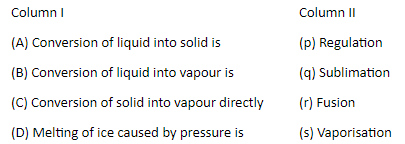
Match the following.


Answer
505.5k+ views
Hint: In order to answer this question, to know which option of column I will match with the options of column II, we will explain each of the given terms and the statement and try to match their respective terms.
Complete answer:
$*$ When solid is heated it gets converted to liquid releasing energy or heat which is also called enthalpy. Hence the process is called Fusion.
Conversion of liquid into solid is Fusion.
So, option (A) of column I is related with option (r) of column II.
$*$ Conversion of liquid into vapour is Vaporisation.
Vaporization (or vaporisation) of an element or compound is a phase transition from the liquid phase to vapour. Vaporization is the process of converting a liquid or solid into a gaseous (vapour) state. The vaporisation process is called boiling when conditions enable the creation of vapour bubbles inside a liquid.
So, option (B) of column I is related with option (s) of column II.
$*$ Conversion of solid into vapour directly is called Sublimation.
Sublimation is a phase in which a solid transforms into a gas without first transforming to a liquid. Sublimation is the term for any solid-to-vapor transformation. Sublimation can be seen in the burning of camphor, iodine, and naphthalene, which is actually evaporation of a solid.
So, option (C) of column I is related with option (q) of column II.
$*$ Melting of ice caused by pressure is known as Regulation.
It is the phenomenon of melting under pressure and freezing, melting of ice caused by pressure is regulation.
So, option (D) of column I is related with option (p) of column II.
Note: There are similarities between all the given terms such as regulation, sublimation, fusion and the vaporisation, due to the effect of temperature in our surroundings, these all given terms occur.
Complete answer:
$*$ When solid is heated it gets converted to liquid releasing energy or heat which is also called enthalpy. Hence the process is called Fusion.
Conversion of liquid into solid is Fusion.
So, option (A) of column I is related with option (r) of column II.
$*$ Conversion of liquid into vapour is Vaporisation.
Vaporization (or vaporisation) of an element or compound is a phase transition from the liquid phase to vapour. Vaporization is the process of converting a liquid or solid into a gaseous (vapour) state. The vaporisation process is called boiling when conditions enable the creation of vapour bubbles inside a liquid.
So, option (B) of column I is related with option (s) of column II.
$*$ Conversion of solid into vapour directly is called Sublimation.
Sublimation is a phase in which a solid transforms into a gas without first transforming to a liquid. Sublimation is the term for any solid-to-vapor transformation. Sublimation can be seen in the burning of camphor, iodine, and naphthalene, which is actually evaporation of a solid.
So, option (C) of column I is related with option (q) of column II.
$*$ Melting of ice caused by pressure is known as Regulation.
It is the phenomenon of melting under pressure and freezing, melting of ice caused by pressure is regulation.
So, option (D) of column I is related with option (p) of column II.
Note: There are similarities between all the given terms such as regulation, sublimation, fusion and the vaporisation, due to the effect of temperature in our surroundings, these all given terms occur.
Recently Updated Pages
Why are manures considered better than fertilizers class 11 biology CBSE

Find the coordinates of the midpoint of the line segment class 11 maths CBSE

Distinguish between static friction limiting friction class 11 physics CBSE

The Chairman of the constituent Assembly was A Jawaharlal class 11 social science CBSE

The first National Commission on Labour NCL submitted class 11 social science CBSE

Number of all subshell of n + l 7 is A 4 B 5 C 6 D class 11 chemistry CBSE

Trending doubts
Differentiate between an exothermic and an endothermic class 11 chemistry CBSE

1 Quintal is equal to a 110 kg b 10 kg c 100kg d 1000 class 11 physics CBSE

Explain zero factorial class 11 maths CBSE

What is boron A Nonmetal B Metal C Metalloid D All class 11 chemistry CBSE

Bond order ofO2 O2+ O2 and O22 is in order A O2 langle class 11 chemistry CBSE

Distinguish between verbal and nonverbal communica class 11 english CBSE




